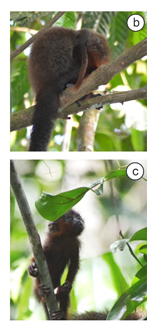Abstract
The Caquetá titi Monkey (Plecturocebus caquetensis) is a critically endangered primate due to the increasing loss of its habitat. In recent years, studies of their behavioral ecology have increased; but little is known about their reproductive behavior. Here we report the first records of reproduction and the birth of one individual of P. caquetensis in each of two observed groups in a forest fragment in Caquetá - Colombia in October 2013. We record the attack of a Pithecia milleri on the adult male while carrying the newborn. These records represent a contribution to the natural history of this endangered species.
References
Acero-Murcia A, Almario LJ, García J, Defler TR, López R. 2018. Diet of the Caquetá titi (Plecturocebus caquetensis) in a disturbed forest fragment in Caquetá, Colombia. Primate Conservation 32:1–17.
Defler TR. 1983. Some populations characteristics of Callicebus torquatus lugens (Humboldt, 1812) (Primates: Cebidae) in eastern Colombia. Lozania (Acta Zoológica Colombiana) 38:1-9.
Defler TR. 2010. Historia natural de los primates colombianos. Segunda edición. Universidad Nacional de Colombia: Bogotá, Colombia.
Defler TR, García J, Almario LJ, Acero-Murcia A, Bueno M, Bloor P, Hoyos M, Arciniegas S, Ibañez C. 2016. Plan de conservación de Callicebus caquetensis. Universidad Nacional de Colombia, Bogotá. https://doi.org/10.13140/RG.2.1.3456.4249
Defler TR, García-Gutiérrez J, Guzmán-Caro DC, Palacios E, Stevenson PR. 2021. Plecturocebus caquetensis. The IUCN red List of threatened species 2021: e.T14699281A192453101. https://dx.doi.org/10.2305/IUCN.UK.2021-1.RLTS.T14699281A192453101.
DeLuycker AM. 2014. Observations of a daytime birthing event in wild titi monkeys (Callicebus oenanthe): implications of the male parental role. Primates 55:59–67. https://doi.org/10.1007/s10329-013-0368-0
Hernández-Camacho J, Cooper RW. 1976. The nonhuman primates of Colombia. In: Thorington WR, Heltne PG, editors. Neotropical primates: field studies and conservation. Washington, USA: National Academy Sciences. p. 35-69.
Instituto de Hidrología, Meteorología y Estudios Ambientales IDEAM. 2014. Informe de datos para Valparaíso, Caquetá, Colombia. Instituto de hidrología, meteorología y estudios ambientales. Bogotá, Colombia.
Janson C, Baldovino MC, Di Bitetti M. 2012. The group life cycle and demography of brown capuchin monkeys (Cebus apella nigritus) in Iguazu national park, Argentina. In: Kappeler PM, Watts DP, editors. Long-term field studies of primates. Berlin, Heidelberg: Springer-Verlag. p. 185–212. https://doi.org/10.1007/978-3-642-22514-7
Kinzey WG. 1981. The titi monkeys, genus Callicebus. In: Coimbra-Filho AF, Mittermeier RA, editors. Ecology and behavior of neotropical primates. Academia Brasileira de Ciências, Rio de Janeiro, Brasil. p. 241-276.
Kinzey WG, Wright PC. 1982. Grooming behavior in the titi monkey (Callicebus torquatus). American Journal of Primatology 3:267–275. https://doi.org/10.1002/ajp.1350030124
Mason WA. 1966. Social organization of the South american monkey, Callicebus moloch: A preliminary report. Tulane Studies in Zoology 13:23–28.
Palacios E, Rodríguez A, Defler TR. 1997. Diet of a group of Callicebus torquatus lugens (Humboldt, 1812) during the annual resource bottleneck in amazonian Colombia. International Journal of Primatology 18:503–522. https://doi.org/10.1023/A:1026307121583
Souza-Alves JP, Mourthe I, Hilário RR, Bicca-Marques JC, Rehg J, Gestich CC, Acero-Murcia AC, Adret P, Aquino R, Berthet M et al. 2019. Terrestrial behavior in titi monkeys (Callicebus, Cheracebus, and Plecturocebus): Potential correlates, patterns, and differences between genera. International Journal of Primatology 40:553–572. https://doi.org/10.1007/s10764-019-00105-x
Strier K, Mendes L. 2009. Long-term field studies of south american primates. In: Garber PA, Estrada A, Bicca-Marques JC, Heymann EW, Strier K, editors. South american primates. New York: Springer International. p. 139–155. https://doi.org/10.1007/978-0-387-78705-3
Spence-Aizenberg A, Di Fiore A, Fernandez-Duque E. 2015. Social monogamy, male–female relationships, and biparental care in wild titi monkeys (Callicebus discolor). Primates 57:103–112. https://doi.org/10.1007/s10329-015-0489-8
Valeggia CR, Mendoza SP, Fernandez-Duque E, Mason WA, Lasley B. 1999. Reproductive biology of female titi monkeys (Callicebus moloch) in captivity. American Journal of Primatology 47:183–195. https://doi.org/10.1002/(SICI)1098-2345(1999)47:3<183::AID-AJP1>3.0.CO;2-J
Van Schaik CP, Brockman DK. 2005. Seasonality in primate ecology, reproduction, and life history: an overview. In: Brockman DK, Van Schaik CP, editors. Seasonality in Primates. New York, USA: Cambridge University Press. p. 3-20. https://doi.org/10.1017/cbo9780511542343
Wright PC. 1990. Patterns of paternal care in primates. International Journal of Primatology 11:89–102. https://doi.org/10.1007/BF02192783
Wright PC. 2013. Callicebus in Manu national park: territory, resources, scent marking and vocalizations. In: Veiga LM, Barnett AA, Ferrari SF, Norconk MA, editors. Evolutionary biology and conservation of titis, sakis and uacaris. New York, USA: Cambridge University Press. p. 232-239. https://doi.org/10.1017/cbo9781139034210

This work is licensed under a Creative Commons Attribution 4.0 International License.






